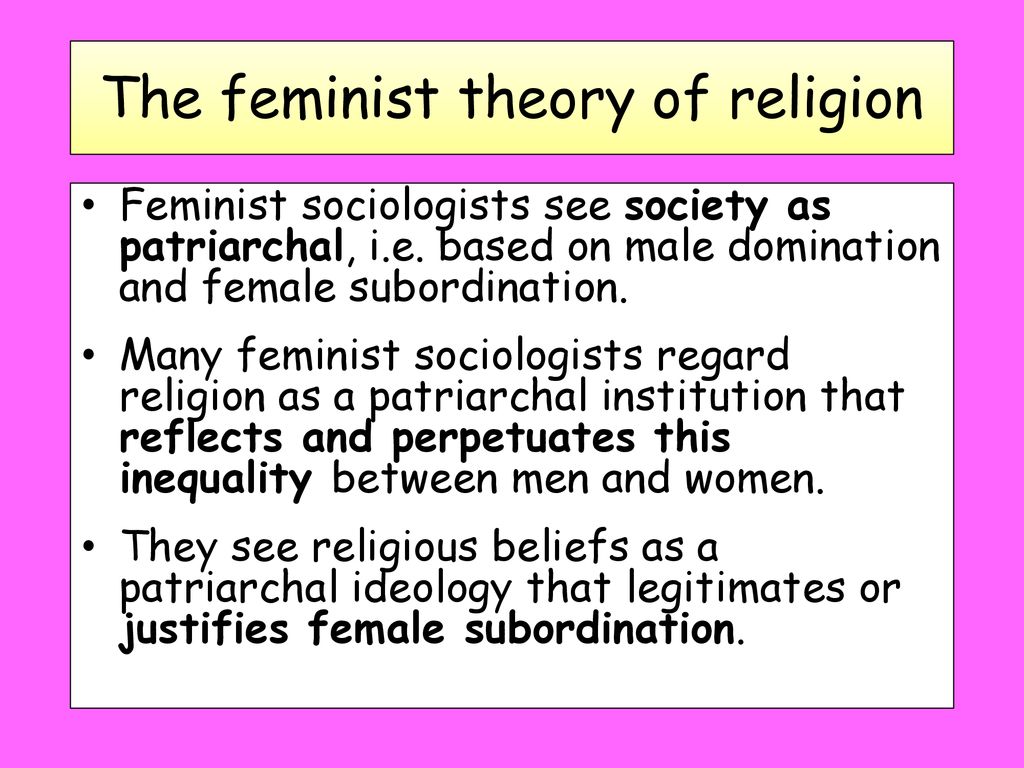Relevance: Sociology: Religion and Society: Sociological theories of religion. Types of religious practices: animism, monism, pluralism, sects, cults. Religion in modern society: religion and science, secularization, religious revivalism, fundamentalism.
Feminist theories of religion analyze and critique the ways in which sacred texts and religious practices portray and subordinate—or empower—women, femininity, and female sexuality .
Theorists within this area of study look at religion’s contribution to the oppression or empowerment of women within society, as well as provide analyses of the challenges that women face within different religious practices.
The crucial insight into religion that forms the basis for feminist research is the gendered nature of religion (Erikson, 1992).

Women’s place and experience within religious traditions differ significantly from men’s.
Feminists therefore argue that questions about gender are essential for a meaningful analysis and explanation of religion.
In one line of inquiry, feminist theorists of religion have analyzed the representation of women within sacred religious texts, identifying and critiquing the way women are portrayed.
For example, the gender of the deity is an issue for women, particularly in the monotheistic Abrahamic religions such as Christianity, Islam, and Judaism (Zwissler, 2012).
God, within these religious beliefs, is usually understood as male. Mary Daly, a feminist theologian, famously stated, “if God is male, then the male is God.”
Individuals within these religious practices are socialized to see men and the qualities of masculinity as having greater importance than women and the qualities femininity, thus perpetuating the rationales and gender ideologies that legitimate women’s subordination in society.
The question this raises is whether religion is therefore the direct cause of misogyny—the aversion or distaste for people of the female sex, including belittling, sexual objectification, sexual violence, and discrimination against women—or whether male-dominated religious practices are the product of broader gendered inequalities and societal norms outside of religion (Zwissler, 2012)?
Feminist theorists note that women are frequently prevented from holding positions of power within religious practice. Ministers, imams, rabbis, buddhas, and Brahmin priests are positions within religious hierarchies which have traditionally excluded women.
Despite this, cross-culturally women are proportionately more religious than men. Surveys across North America and Europe demonstrate that more women identify as being religious than men, have deeper levels of religiosity than men, and attend church more regularly tan men by a ratio of 3:2 (Dawson & Thiessen, 2014).
This can be seen as a paradox within feminist religious studies. In an ideal meritocracy, spiritual elites would be chosen from those with the most spiritual “experience,” but this is not the case.
Linda Woodhead’s research seeks to examine the question of why more women than men identify as being religious when religions are typically patriarchal, both in their contents and their institutional hierarchies.
Her key insight is that women’s position in patriarchal religion is not monolithic. Women differ in how they “negotiate” their gender status and their religious practice.
Placed along two axes , Woodhead identifies four distinct religious “strategies” women adopt to position themselves within the dominant religious narrative (“mainstream” or “marginal”) and with respect to the religious status quo (“confirmatory” or “challenging”):
- The consolidating strategy of women who accept the existing gendered distribution of power within their religion as a means of affirming and consolidating the security and predictability that traditional gender roles provide;
- The tactical strategy of women who take part in and use religion in order to have the intimate interaction and support of other women;
- The questing strategy of women who seek out different forms of religion like New Age spiritualties, meditation or Wikka in order to find fulfilment through an inner spiritual quest (rather than addressing the social power structures of religion directly);
- The counter-cultural strategy of women that reject traditional religion and create religious communities that focus on empowering women (eg. the goddess feminist movement of Starhawk and others).
The challenges faced by women are different within each religion, and therefore the strategies women of faith use to change or work within their respective religion may vary.
Woodhead’s model emphasizes however that women are not simply manipulated by religious traditions but exercise agency, albeit with different orientations and goals (Woodhead, 2007).

